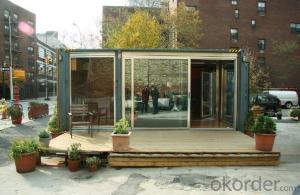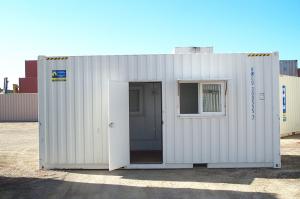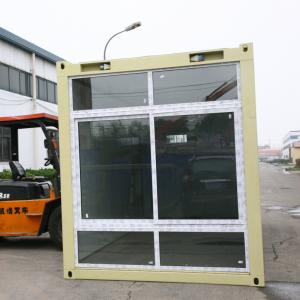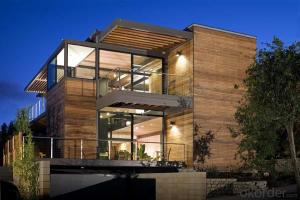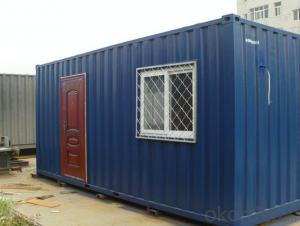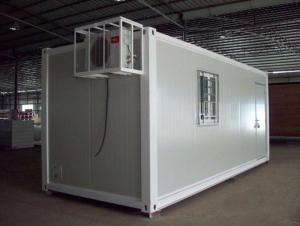Container house / container home / prefab house
- Loading Port:
- Tianjin
- Payment Terms:
- TT OR LC
- Min Order Qty:
- 7 set
- Supply Capability:
- 200000 set/month
OKorder Service Pledge
OKorder Financial Service
You Might Also Like
Container house / container home / prefab house


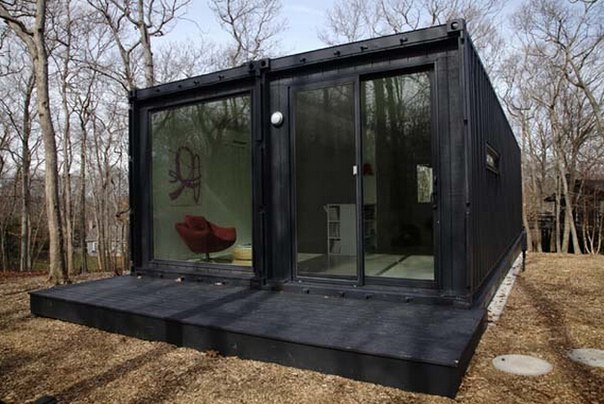
Specifications
Design Portable Modular Container Houses
1.Fast Installment & Energy Saving
2.Low Cost
Container houses are based on shipping containers, module structure construction and interior decoration are finished in the factory using manufacturing production. These modules can be fast assembled into houses with various styles according to different uses and functions on site. Interior decoration, in accordance with local national standards for water, electric, fireproof, sound insulation, heat preservation, environmental protection and all other requirements .
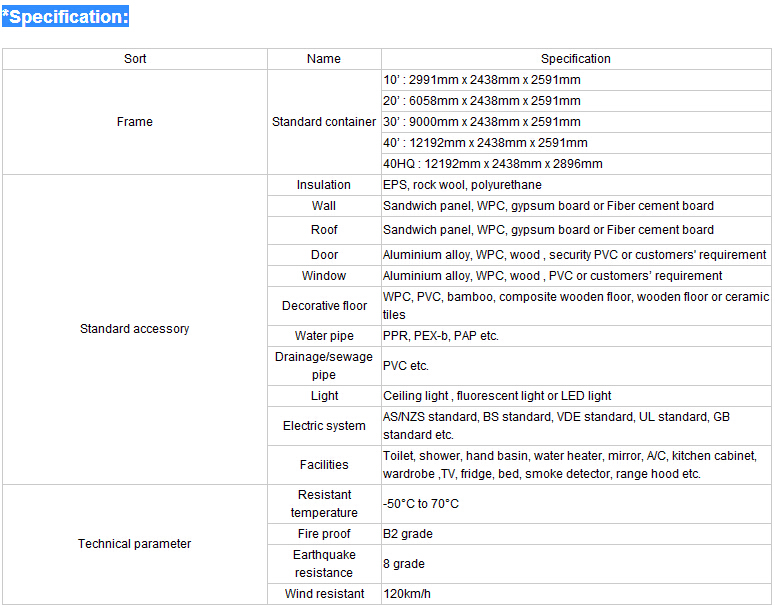
Production information of container houses:
*Packaging:
Bubble foil, plywood based, or metal frame box on client’s requirements.
20’ SOC container can load 4 units 20’ unit, 40’ HQ SOC can load 4 units 40’ units, 40’HQ can load 4X30’ units.
All the materials are well fixed and tight to prevent the moving during the transport.
Customized are available.
*Delivery Detail:
30 days after deposit confirmed
Product types: container house / container home / container office / container hotel / prefab houses
Some designs to show:
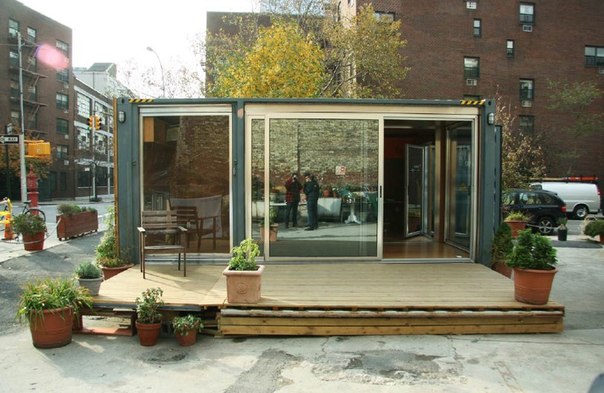
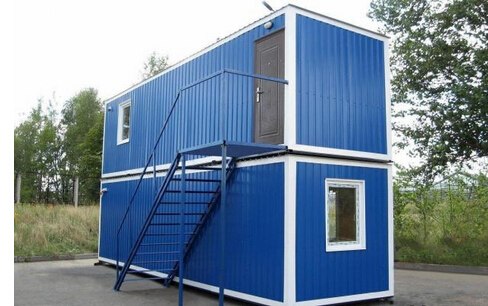
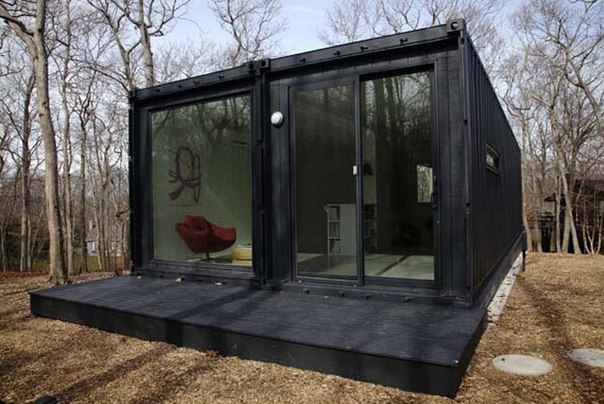
The construction cases to show:

- Q:Are container houses suitable for year-round living?
- Yes, container houses can be suitable for year-round living. These houses are built using shipping containers, which are incredibly durable and can withstand harsh weather conditions. With proper insulation and modifications, container houses can provide comfortable living spaces throughout the year. One of the main advantages of container houses for year-round living is their ability to withstand extreme temperatures. These structures can be insulated with materials such as foam or spray foam insulation, which helps to regulate the indoor temperature. Additionally, double-glazed windows and efficient heating and cooling systems can be installed to further enhance the comfort of the living space. Container houses can also be designed to incorporate all the necessary amenities for year-round living. They can be equipped with plumbing, electricity, and HVAC systems, just like traditional houses. Adequate space planning and design can ensure that all essential areas, such as bedrooms, bathrooms, kitchen, and living areas, are included in the container house. Furthermore, container houses are eco-friendly and cost-effective options for year-round living. The use of repurposed shipping containers reduces waste and overall construction costs. Additionally, these houses are highly customizable and can be designed to be energy-efficient, utilizing renewable energy sources such as solar panels. However, it is important to consider certain factors when considering container houses for year-round living. Proper site selection and foundation preparation are crucial to ensure stability and durability. Additionally, adequate ventilation and moisture control measures should be taken to prevent any potential issues related to condensation or mold growth. In conclusion, container houses can indeed be suitable for year-round living. With proper insulation, design, and amenities, these houses can provide comfortable and sustainable living spaces throughout the year. However, it is essential to address any potential challenges and ensure proper construction techniques to make container houses a viable option for year-round living.
- Q:Can container houses be designed to have a rustic or industrial look?
- Yes, container houses can be designed to have a rustic or industrial look. With the right choice of materials, finishes, and architectural design, container houses can be transformed into aesthetically pleasing homes that embrace the rustic charm or industrial aesthetics. From incorporating reclaimed wood, exposed brickwork, and earthy color palettes for a rustic feel, to utilizing metal accents, concrete finishes, and minimalistic design for an industrial look, container houses offer flexibility and creativity in achieving various architectural styles.
- Q:Are container houses prone to rusting?
- Container houses are typically made of steel, which is known to be susceptible to rusting. However, with proper maintenance and treatment, container houses can be protected against rusting. Most container houses undergo a process called corten steel treatment, which involves the application of a protective layer to prevent rust formation. Additionally, regular inspections and maintenance can help identify and address any potential rusting issues. It is important to note that the durability and longevity of a container house depend on various factors including the quality of the steel used, climate conditions, and maintenance efforts. Overall, while container houses can be prone to rusting, proper care and maintenance can ensure their longevity and structural integrity.
- Q:Are container houses suitable for individuals who enjoy gardening?
- Individuals who have a penchant for gardening will find container houses to be a perfect fit. The advantages they offer to garden enthusiasts are truly exceptional. One of the key benefits is the ability to create a rooftop or balcony garden, even in areas where space is scarce, such as urban environments. Containers can effortlessly be placed on the roof or balcony, allowing for the cultivation of a diverse range of plants, flowers, and even vegetables. Container houses also provide an opportunity for vertical gardening. Through the use of trellises, hanging baskets, or wall-mounted planters, gardeners can make the most of their vertical space and create a flourishing and vibrant garden. This is especially advantageous for those with limited ground space, but who still wish to relish the beauty and benefits of gardening. Furthermore, container houses offer a controlled environment for gardening. The containers can be easily insulated, ensuring better temperature control and protection against severe weather conditions. This enables individuals to grow plants that may not be suited to their region's climate or extend the growing season for certain crops. Additionally, container houses typically possess ample natural lighting due to their large windows or skylights, providing the perfect conditions for plants to thrive. Moreover, container houses are often designed with sustainability in mind. Many containers are repurposed from shipping containers, contributing to waste reduction and the promotion of recycling. Additionally, container houses can incorporate sustainable features like rainwater harvesting systems or composting toilets, further enhancing the eco-friendly aspect of gardening. To summarize, container houses are an excellent choice for gardening enthusiasts. They offer unique opportunities for rooftop or balcony gardens, vertical gardening, and a controlled environment for cultivating a wide variety of plants. With their sustainability features and effective utilization of limited space, container houses provide a splendid platform for garden enthusiasts to indulge in their passion for gardening.
- Q:Are container houses suitable for eco-resorts?
- Container houses are indeed appropriate for eco-resorts due to several reasons. Firstly, they are a sustainable and eco-friendly choice as they repurpose old shipping containers, granting them a new lease on life instead of allowing them to go to waste. This helps decrease the demand for new construction materials and minimizes the impact on the environment. Secondly, container houses are highly energy-efficient. By adequately insulating and ventilating them, they can maintain comfortable temperatures without excessive energy consumption. This is of particular significance for eco-resorts that strive to minimize their carbon footprint and promote sustainable practices. Furthermore, container houses can effortlessly blend into the natural landscape of an eco-resort. They can be arranged in various configurations, allowing for a seamless integration with the surrounding environment. This guarantees that the resort maintains a visually unobtrusive presence and preserves the area's natural beauty. Moreover, container houses offer flexibility and scalability to eco-resorts. As the demand for accommodation fluctuates, additional container units can be added or removed, enabling efficient space management. This adaptability empowers eco-resorts to optimize their resources and reduce waste. Lastly, container houses are often more affordable compared to traditional construction methods. This affordability could make eco-resorts more accessible to a broader range of travelers, promoting sustainable tourism and raising awareness about environmental issues. To conclude, container houses are a suitable and sustainable choice for eco-resorts. They provide environmental benefits, energy efficiency, integration with nature, flexibility, and affordability. By incorporating container houses into their designs, eco-resorts can further enhance their commitment to sustainability and offer guests a distinct and eco-friendly experience.
- Q:Can container houses be designed with a small footprint?
- Yes, container houses can be designed with a small footprint. Their modular nature allows for flexibility in design and layout, making it possible to create compact and efficient living spaces. Additionally, incorporating sustainable features such as solar panels and rainwater harvesting systems further reduces their environmental impact.
- Q:Are container houses suitable for co-living or shared housing?
- Yes, container houses are suitable for co-living or shared housing. Container houses offer several advantages for this type of living arrangement. Firstly, they are highly customizable and can be easily modified to accommodate multiple individuals or families. The modular nature of container houses allows for the creation of separate living spaces within the same structure, providing privacy and personal space for each resident. Secondly, container houses are cost-effective, making them an ideal option for shared housing. The construction and maintenance costs of container houses are generally lower compared to traditional housing, which can help reduce the financial burden on the residents. Additionally, container houses are energy-efficient and can be equipped with sustainable features such as solar panels, rainwater harvesting systems, and energy-efficient appliances, further reducing utility costs and promoting an eco-friendly lifestyle. Container houses also offer flexibility in terms of location. They can be easily transported and can be set up in various locations, making it easier for co-living communities to establish homes in urban or rural areas. This flexibility allows residents to choose a location that suits their needs, whether it is close to their workplaces, educational institutions, or social amenities. Furthermore, container houses can promote a sense of community and shared responsibility. Living in close proximity to one another fosters social interaction and encourages residents to collaborate on shared tasks, such as maintaining common areas or organizing community events. This sense of community can enhance the overall living experience and create a supportive environment for co-living residents. In conclusion, container houses are well-suited for co-living or shared housing due to their flexibility, cost-effectiveness, and ability to create separate living spaces within a single structure. They offer a unique opportunity to build sustainable and affordable communities, fostering a sense of togetherness while providing the necessary privacy and personal space for each resident.
- Q:Are container houses suitable for educational facilities?
- Yes, container houses can be suitable for educational facilities. They offer several advantages such as cost-effectiveness, quick construction time, and flexibility in design. Container houses can be customized to create classrooms, libraries, or administrative spaces. Additionally, they are portable and can be easily relocated if needed. However, proper insulation, ventilation, and structural modifications must be ensured to meet the specific requirements of educational facilities.
- Q:Can container houses be designed with a wine cellar or wine room?
- Yes, container houses can be designed with a wine cellar or wine room. With proper planning and design, containers can be modified to accommodate temperature and humidity control, ensuring optimal conditions for storing wine. The size and layout of the container can be adjusted to create a dedicated space for wine storage, complete with appropriate insulation, ventilation, and shelving systems.
- Q:Can container houses be designed to have large windows?
- Certainly, it is possible for container houses to feature spacious windows. Although the structural design of shipping containers may impose restrictions on window placement, creative architects and designers have devised ingenious methods to integrate expansive windows into container homes. By skillfully carving openings in the walls and fortifying the structure, containers can be converted into dwellings that enjoy abundant natural light and breathtaking vistas. Furthermore, containers can be stacked or interconnected to form more extensive living areas, opening up further possibilities for incorporating sizable windows. With meticulous attention to design and engineering aspects, container houses can be aesthetically enhanced with ample, visually appealing windows.
1. Manufacturer Overview |
|
|---|---|
| Location | |
| Year Established | |
| Annual Output Value | |
| Main Markets | |
| Company Certifications | |
2. Manufacturer Certificates |
|
|---|---|
| a) Certification Name | |
| Range | |
| Reference | |
| Validity Period | |
3. Manufacturer Capability |
|
|---|---|
| a)Trade Capacity | |
| Nearest Port | |
| Export Percentage | |
| No.of Employees in Trade Department | |
| Language Spoken: | |
| b)Factory Information | |
| Factory Size: | |
| No. of Production Lines | |
| Contract Manufacturing | |
| Product Price Range | |
Send your message to us
Container house / container home / prefab house
- Loading Port:
- Tianjin
- Payment Terms:
- TT OR LC
- Min Order Qty:
- 7 set
- Supply Capability:
- 200000 set/month
OKorder Service Pledge
OKorder Financial Service
Similar products
New products
Hot products
Related keywords

